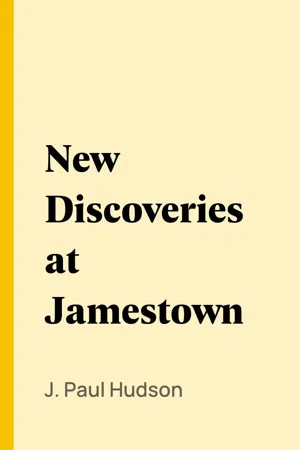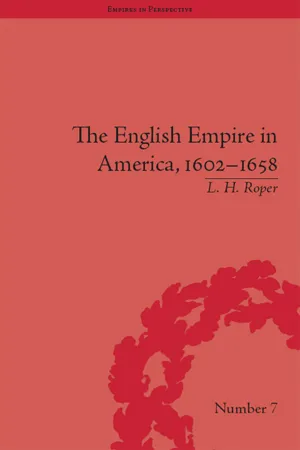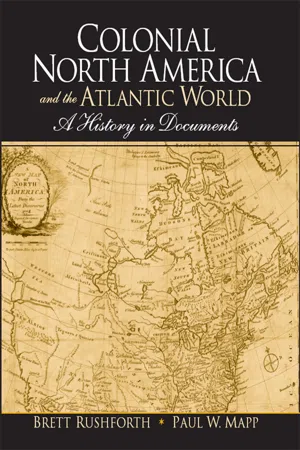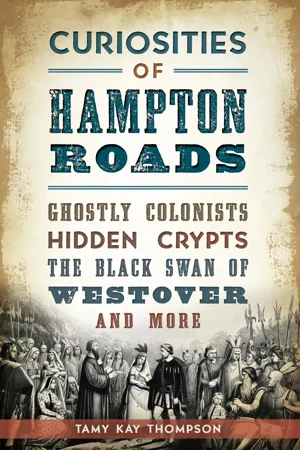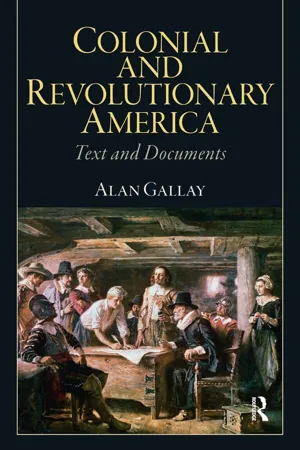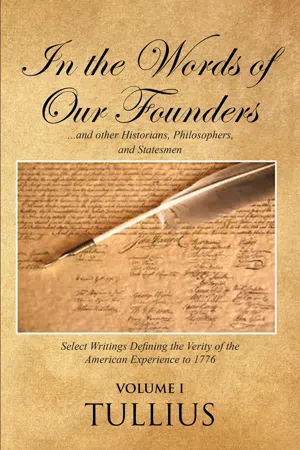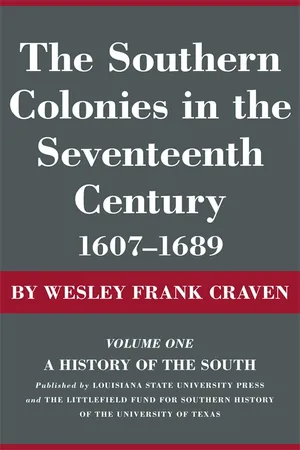History
Jamestown
Jamestown was the first permanent English settlement in North America, established in 1607 in what is now Virginia. It was founded by the Virginia Company and played a significant role in the early history of the United States. Jamestown faced numerous challenges, including conflicts with Native Americans and disease, but ultimately became a thriving colony and a key part of American colonial history.
Written by Perlego with AI-assistance
Related key terms
9 Key excerpts on "Jamestown"
- eBook - ePub
New Discoveries at Jamestown
Site of the First Successful English Settlement in America
- J. Paul Hudson(Author)
- 2005(Publication Date)
- Perlego(Publisher)
[Illustration]New Discoveries at JamestownSite of the First Successful English Settlement in AmericaBy John L. Cotter and J. Paul HudsonWashington, D.C., 1957[Illustration] United States Department of the InteriorFred A. Seaton, SecretaryNational Park ServiceConrad L. Wirth, Director[Illustration] For sale by the Superintendent of Documents, U.S. Government Printing Office Washington 25, D.C. - Price 50 centsPreface
Jamestown , a name of first rank among historic names, saw the birth of English America. Here on an island in the James River in the heart of tidewater Virginia the English carved a settlement out of the wilderness. It grew from a rude palisaded fort into a busy community and then into a small town that enjoyed many of the comforts of daily living. For 13 years (until 1620) Virginia was the only English colony on the American mainland. Jamestown served this colony as its place of origin and as its capital for 92 years—from 1607 to 1699.After its first century of prominence and leadership, “James Towne” entered a long decline, precipitated, in 1700, by the removal of the seat of government to Williamsburg. Its residents drifted away, its streets grew silent, its buildings decayed, and even its lots and former public places became cultivated fields. Time passed and much was forgotten or obscured. So it was when it became a historic area, in part, in 1893, and when the whole island became devoted to historical purposes in 1934.Since these dates, the Association for the Preservation of Virginia Antiquities and the National Park Service have worked toward the preservation of all that still exists of old Jamestown, and are dedicated to learning its story more completely. Thus the American people can more fully understand and enjoy their historic heritage of Jamestown. A great deal of study along many lines has been required and much more is still needed to fill the many gaps. Libraries have been searched for pictures, documents, and plans. Land records have been carefully scrutinized and old existing landmarks studied. Seventeenth-century buildings and objects still surviving in England, America, and elsewhere have been viewed as well as museum collections. A key part of the search has been the systematic excavation of the townsite itself, in order to bring to light the information and objects long buried there. This is the aspect of the broad Jamestown study that is told in this publication, particularly as its relates to the material things, large and small, of daily life in Jamestown in the 17th century. - eBook - ePub
Archaeologies of Placemaking
Monuments, Memories, and Engagement in Native North America
- Patricia E Rubertone(Author)
- 2016(Publication Date)
- Routledge(Publisher)
permanent English colony in America was abandoned as a town within a century, though it became home to two farms (Blanton 2003).Jamestown AS MONUMENT IN 2007
Jamestown Island today is called Historic Jamestowne, a monument managed by the National Park Service (NPS) and the privately funded Association for the Preservation of Virginia Antiquities (APVA). The National Park Service controls most of Jamestown Island, but the ruins of the original fort and an associated church from the seventeenth century are APVA property. As the town of Jamestown expanded and contracted, an early urban space was created (Horning 2000); the NPS notes the footprint of these ruins, but they were not much a part of the commemoration in 2007. The Commonwealth of Virginia created a popular living history reconstruction of the fort and a Powhatan village, with associated museum exhibits, in connection with the 350th anniversary celebration in 1957. The APVA has focused since the late nineteenth century on preserving a Jamestown-era brick church and, since 1994, on the recovery of the original fort through intensive archaeological study (Kelso 2006; Lindgren 1993). The National Park Service virtually pioneered American historical archaeology at Jamestown (Cotter 1958) and uncovered remains of the statehouse in which the previously noted first General Assembly took place. In the 1990s, the NPS funded a survey of all of Jamestown Island, resulting in a broader context for understanding the fort in its environmental context and a deeper history of Indian life on the island (Blanton 2003). Finally, the Commonwealth of Virginia maintains its living history museum and, for 2007, opened a vastly expanded and impressive indoor museum depicting the historical and cultural contexts of Native Americans (Powhatans), West Africans (Angolans), and Europeans (English). Once called the Jamestown Festival Park (in 1957), it is today more soberly called the Jamestown Settlement (see Figure 9.1 - eBook - ePub
The English Empire in America, 1602-1658
Beyond Jamestown
- L H Roper(Author)
- 2015(Publication Date)
- Routledge(Publisher)
8Thus, according to an ‘Atlantic’ account of Jamestown released in conjunction with the 400th anniversary of its founding, ‘the first permanent English settlement in the territory that would become the United States’ constituted ‘the tiny seed from which would grow a powerful nation where all the world’s people would mingle’. This seed came to flourish through ‘trial and error – and error often predominated’ employed by the settlers, a number of whom ‘had had experience of other Atlantic and Mediterranean regions before they came together on the James River’, over a decade or so after 1607. In doing so, the emerging society overthrew the ‘hierarchical arrangements’ devised by the Virginia Company, which had also conceived ‘notoriously unrealizable goals’ for its colony. The ‘improvisation, undertaken by ordinary people’ with the people and the land they found, created ‘the outlines of genuinely American society, with all its virtues and defects’ and made ‘elites nervous’ as they ‘set about the task of building families and family farms’ – a characterization with which the Progressive historian Turner would have readily concurred.9The shadow of another eminent Victorian also still hovers over the counterpart of colonial British America, the early history of the Anglo-British Empire. Five years before Turner’s appearance at the World’s Columbian Exposition in Chicago in 1893, Sir J. R. Seeley declared that the British Empire was founded in a ‘fit of absent-mindedness’.10 Even today, historians of the early modern English state offer their considerations (in which the expansion of its ‘empire’ during the seventeenth century, of course, played a part) in terms of Seeley’s characterization of an essentially accidental empire. They do so even as they have struggled to come to terms with a revamped understanding of the social and political world over which the Tudor and Stuart monarchs ruled. At the same time, the Whiggish/Marxist ‘high road’ to the English Civil Wars, culminating in the triumph of ‘liberty’ or of the bourgeoisie (depending on one’s point of view), which was first laid coincidentally with Turner’s construction in the United States, has undergone substantial revision and post-revision. These investigations have yielded a re-evaluation of the meaning of ‘liberty’ to contemporaries, a more nuanced understanding of the powers and limits of early modern English government, and a greater appreciation of the importance of politics and religion to this history.11 - eBook - ePub
Colonial North America and the Atlantic World
A History in Documents
- Brett Rushforth, Paul Mapp(Authors)
- 2016(Publication Date)
- Routledge(Publisher)
6 Virginia DOI: 10.4324/9781315510330-6Envious of Spain’s American wealth, and fearful that growing Spanish power would jeopardize English security, the English crown started in the 1580s to support American colonial ventures. Beginning with a failed attempt on Roanoke Island, off the coast of present-day North Carolina, the English eventually established their first permanent settlement at Jamestown, Virginia, in 1607. The documents in this chapter discuss the origins of English colonial settlement in North America, concentrating on Virginia’s tumultuous early years.6.1 A Plan for English Colonization of North America*
* Richard Hakluyt, “Discourse on Western Planting, Written in the Year 1584” in Documentary History of the State of Maine, ed. Charles Deane (Cambridge, 1877), vol. 2: 3–5.Written in 1584 to convince Queen Elizabeth I to support North American colonization, Richard Hakluyt’s “Discourse on Western Planting” represents one of the earliest and most coherent expressions of England’s New World ambitions. The following selection is an extended table of contents serving as a summary of the book’s major points. Hakluyt, an elder cousin who shared his name, and a small group of wealthy investors that included Sir Walter Raleigh, hoped to profit both from English trade and from anti-Spanish piracy conducted from England’s new American colonies. Shortly after Hakluyt’s work was published, the queen granted Raleigh the first English license to settle in North America - eBook - ePub
Curiosities of Hampton Roads
Ghostly Colonists, Hidden Crypts, the Black Swan of Westover, and More
- Tamy Kay Thompson(Author)
- 2015(Publication Date)
- The History Press(Publisher)
3 JamestownJamestown, named after King James I of England, was the first permanent English settlement established in America. The Virginia Company of London financially backed the expedition to America, and Captain Christopher Newport led it. Captain Newport also steered the Susan Constant, John Ratcliffe was the captain of the Discovery and Bartholomew Gosnold steered the Godspeed. Over one hundred men boarded the three ships less than a week before Christmas 1606, but winds delayed them for six weeks. They reached the islands of the West Indies off the coast of South America in late March 1607, when the first Englishman died. George Percy recorded that Edward Brookes’s “fat melted within him by the great heat and drought of the country.”On April 26, 1607, the three ships landed at Cape Henry, and that night, the Indians chased the men back to their ships. Gabriel Archer and another man were wounded. A sealed box was opened that day, the contents of which will be discussed momentarily. Shortly thereafter, Captain John Smith was released; he had been shackled below deck on Captain Ratcliffe’s ship because he’d been accused of mutiny during the voyage (he and Edward Wingfield had argued about the route Newport was taking). A few days later, the settlers erected a cross at Cape Henry.On April 30, the settlers began traveling up the James River to look for a settlement site, and they feasted with the Indians at Kecoughtan (present-day Hampton) for the first time. Maize bread and pipes of tobacco were shared, and then the settlers were treated to singing and dancing before Captain Newport gave the Indians beads from England, which were much appreciated because the Indians liked adornments. Before the English had arrived, the Indian men decorated their ears and animal-hide clothing with animal bones. They also inserted feathers into the left side of their long hair (the right side was shaved) and painted their bodies red or black. - eBook - ePub
Religious Life of Virginia in the Seventeenth Century
The Faith of Our Fathers
- G. MacLaren (George MacLaren) Brydon(Author)
- 2009(Publication Date)
- Perlego(Publisher)
Following the failure of this first effort, a plan was formulated and established by charter given by King James in the year 1606. Under this charter companies were to be formed in order to found two English settlements in America; one to be a colony at some point between the 34th and 41st degrees of latitude, and the other between the 38th and 45th degrees. Both companies had the widespread interest of the English people, and both made settlements in America in the same year, 1607. The Virginia Company established its settlement at Jamestown, from which developed the Colony, and later the Commonwealth of Virginia, as the first permanent English settlement in America. The Plymouth Company made its settlement upon the coast of what is now Maine; but this effort failed and the colonists returned home in the following year. Permanent settlement of New England began in 1620 with the coming of the Pilgrims to Plymouth, Massachusetts. From these two first settlements thus widely separated, but with their common ideal of English civilization and English concepts of freedom and self-government, has grown the American nation of today. This nation, while welcoming all the gifts and values which people of other nations have brought to the enrichment and broadening of our common life, is still basically an English or Anglo-Saxon nation.Many impelling motives animated the men who organized the Virginia company and labored for the establishment of a colony in America. They wanted of course the expansion of British trade and a wider market for British manufactures; and they naturally hoped for financial profit from their investment in shares of stock in the companies. They planned, also, not merely trading posts in a foreign land as in India and elsewhere, but an extension and expansion of the empire of Great Britain.A most important part of their plan was to make colonies the answer to a problem which was pressing for solution: the problem of what to do with the increasing overplus of population in many of the cities of England. The danger of a population too great for the land of England to support and feed was a real one. A colony to which England could send her overplus population as part of a greater England was a real solution, and a better one than would be the raising of grain and foodstuff by foreign countries to feed the hungry of Great Britain. That men were thinking along this line appears from the action of certain large towns in paying the expense of the voyage of young people by the score or hundred to Virginia, and from the plan soon after the first settlement, whereby young women of reputable families were sent to Virginia to become wives of the colonists. - eBook - ePub
- Alan Gallay(Author)
- 2016(Publication Date)
- Routledge(Publisher)
Ralegh also made it a practice to bring Indians to England, or to have his ship captains do the same, with the Indians’ permission, where they could teach him and his associates about their culture and language, and in return learn about English culture and language. Some of these Indians became lifelong friends of Ralegh; all were permitted to return to America. Ralegh’s long-term imprisonment under King James I prevented him from becoming involved in England’s next attempt to settle Virginia, though he invested money in the enterprise. A group of merchants formed the London Company (later renamed the Virginia Company) in 1606 and convinced James I to allow them to once again attempt a settlement, named Jamestown for their monarch.Virginia: The First Permanent English Colony in the Americas
Three ships brought 104 colonists in 1607 to Chesapeake Bay, a much better place to settle than Roanoke due to the quality of the land and suitability for defense and expansion. Nevertheless, the colony barely survived its early years. The first settlers were mostly soldiers, “adventurers,” and their servants. The adventurers were largely “Second Sons.” In England, the laws of primogeniture and entail provided that first-born males inherited their father’s land, so estates would not be divided. The second sons of elites ordinarily became military officers, lawyers, merchants, or clergymen. In Virginia, they hoped to gather an estate and return to England. Few intended to stay—what would be the purpose of being rich in Virginia. The settlers spent much of their time looking for precious metals and a passage to Asia, and little time securing their survival.The Starving Times
Survival was difficult and the men ill-suited to the task. The colony faced starvation. John Smith, the colony’s leader, cajoled, intimidated, and forced the men to work, while seeking a variety of ways to obtain food from the Indians. But when Smith hurt his arm and returned to England for medical treatment, the colony floundered.Relations with the neighboring Powhatan were never good. These Indians comprised a chiefdom of many peoples led by Powhatan, whose daughter Pocahontas, according to Smith, had saved him from death at the hands of her father, and who later married John Rolfe and went with him to England where she died of illness. Relations deteriorated when the English arrogantly demanded corn and other assistance from the Powhatan, who moved inland, leaving the English to their own devices. - eBook - ePub
In the Words of Our Founders
...and other Historians, Philosophers, and Statesmen
- Tullius(Author)
- 2019(Publication Date)
- Christian Faith Publishing, Inc.(Publisher)
But by 1614, he was back at the expedition-game, traveling and mapping the coast lines of present-day Maine and Massachusetts and naming the area “New England.” However, the return trip was cut short after he met up with pirates in the Azores off the coast of Portugal and found himself imprisoned. Amazingly, he escaped and made it back to England where he decided to take up his pen. Even after this tumult of a journey, he was still determined to return again to the area. The following year he published his work, Description of New England (1616), which proved quite effective in rallying others to invest and colonize the newly found area, including the Virginia Company, the king, and the Puritans. At the news of the Jamestown massacre, in 1622, he volunteered to go back to the region to settle scores, but the Virginia Company declined the offer. As for the actual settlement of Jamestown, it received a new charter, in 1612, (resulting in a much-needed influx of capital to further its stability and growth), which firmly established its own elective Assembly and allowed it to become an example for other colonies throughout the remainder of the 18 th century. However, as a result of Bacon’s rebellion, in 1676, and a destructive fire, in 1698, Jamestown died on the vine and was forced to relocate to present-day Williamsburg. Today, Jamestown attracts tourists from around the United States that includes both a theme park and a replica of the Susan Constance, one of the original ships of the armada. British colonialism had three primary goals: First, to bring Christianity to the inhabitants of the New World —at least it made this claim in the original Charter of 1606. Second, was to locate a passage to the Orient which, after countless expeditions proved fruitless. Third, to harness the natural resources for the enrichment of others which proved more successful than the previous two - eBook - ePub
The Southern Colonies in the Seventeenth Century, 1607--1689
A History of the South
- Wesley Frank Craven(Author)
- 2015(Publication Date)
- LSU Press(Publisher)
CHAPTER IIIJamestown
I T IS not always possible to speak with certainty regarding the Jamestown settlement. Some of the more pertinent records of the English government have been irreparably lost by fire. Official minutes of the proceedings of the Virginia Company itself are known to exist only for the years following 1618.1 The story of the colony prior to that time must be pieced together from sources that are not only fragmentary but are frequently given over to special pleading and personal recrimination. No other period of American history has so lent itself to the inclination of some writers to read into the record whatever interpretation appeared at the moment to serve best the national or sectional interest. It has been used to demonstrate the fallacies of communism, and more recently in attempts to establish the point that fascism has also been tried in this country and found wanting. The ease with which these obviously misleading views of the period have attained wide popularity suggests the difficulty scholars have experienced in presenting a true picture.Unquestionably, the central theme of Virginia’s early history is the pursuit of that national interest which the Hakluyts had placed at the very heart of their program for American settlement. It is proper to emphasize the newly-awakened interest of the great merchants of London and their growing influence in the company under the leadership of Sir Thomas Smith, London’s greatest merchant prince. Indeed, the significance of this first chapter of our history can be fully comprehended only by giving close attention to the role of the merchants and particularly to the usages borrowed for management of the enterprise from the experience of England’s leading mercantile community. But in this necessary emphasis lies grave danger of overemphasis and the risk that a narrow view of the merchants’ interest may distort a chronicle of epic proportions. Membership in the London Company was by no means limited to the merchants; moreover, such men as Smith, whose activity in behalf of England’s trade ranged from the Spice Islands and India in the East to Virginia and Hudson Bay in the West, were more than mere tradesmen. The Virginia Company, like the East India Company, must be considered in terms of the large purpose it sought to serve. Called into existence when the state chose not to assume the lead in empire building, it can be understood only as an instrument for the achievement of national ends.
Index pages curate the most relevant extracts from our library of academic textbooks. They’ve been created using an in-house natural language model (NLM), each adding context and meaning to key research topics.
